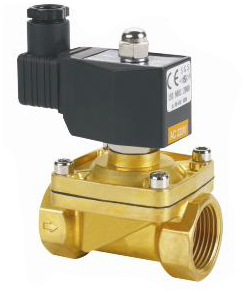What is a Solenoid Valve ?
A solenoid valve is an electromechanical device used for controlling liquid or gas flow. The solenid valve is controlled by electrical current, which is run through a coil. When the coil is energized, a magnetic field is created, causing a plunger inside the coil to move. Depending on the design of the valve, the plunger will either open  or close the valve. When electrical current is removed from the coil, the valve will return to its de-energized state.
or close the valve. When electrical current is removed from the coil, the valve will return to its de-energized state.
In direct-acting solenoid valves, the plunger directly opens and closes an orifice inside the valve. In pilot-operated valves (also called the servo-type), the plunger opens and closes a pilot orifice. The inletline pressure, which is led through the pilot orifice, opens and closes the valve seal.
The most common solenoid valve has two ports: an inlet port and an outlet port. Advanced desigs may have three or more ports. Some designs utilize a manifold-type design.
Solenoid valves make automation of fluid and gas control possible. Modern solenoid valves offer fast operation, high reliability, long service life, and compact design.